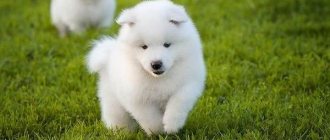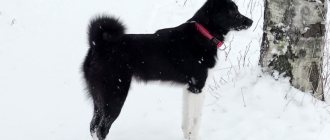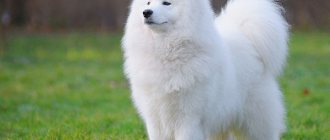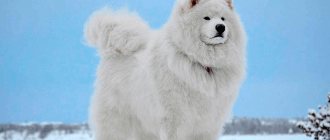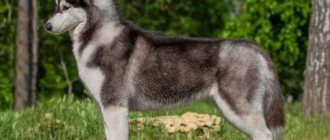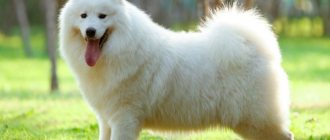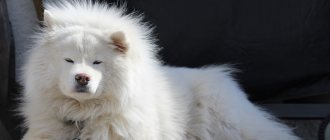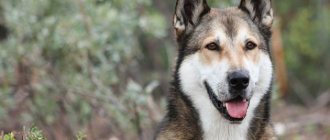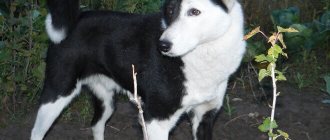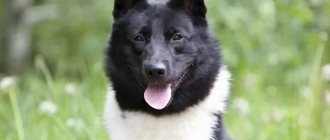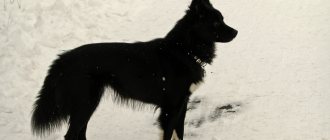Contents of the Samoyed Laika
It is enough to walk for 1-1.5 hours twice a day. In summer, the most optimal time is when the heat has not yet begun and in the evening, when it subsides. You should definitely take a water bowl and bottle with you to give your dog a drink from time to time. The leash should be long and preferably adjustable.
The Samoyed dog needs constant communication - this is one of the most important conditions in keeping a pet.
It is better to get a dog while living in a country house. The apartment is suitable if you have more than 3 rooms.
Samoyeds are not intended to be chained; these dogs are extremely freedom-loving.
If the Samoyed is kept in an enclosure, then it should be spacious and free.
Health and illness
Samoyeds have lived for centuries in harsh northern conditions, so they have good health. They have good genetics and developed immunity, but some characteristic diseases are still inherent in dogs.
The most common ones are:
- diseases of the cardiovascular system;
- glaucoma;
- volvulus, stomach problems can be acquired. Can form due to excess physical. stress or injury. In this case, the dog requires immediate veterinary assistance, otherwise the animal will die;
- Arthritis often develops in old age. The disease cannot be completely cured, but by timely relief of attacks it is possible to ensure that the pet lives a full life without experiencing pain;
- joint dysplasia (hip or elbow) can be both congenital and acquired. If you contact a specialist in a timely manner, it responds well to therapy. Pathology can be replaced by limping, difficulty in movement;
- diabetes;
- cataract;
- pathologies of the thyroid gland;
- retinal atrophy.
Like any other breed, Samoyeds are susceptible to life-threatening infectious diseases. Such as plague, hepatitis, rabies, parvovirus enteritis and others. You can protect your pet from them only through vaccination. The puppy should receive its first vaccinations from the breeder - at 1-1.5 months. Repeated vaccination takes place:
- at two months;
- at three months;
- after changing teeth;
- at one year of age.
Then annual revaccination is carried out.
Lifespan
The Samoyed dog lives on average from 12 to 15 years , but there are also centenarians who have reached the age of twenty.
The quality and life expectancy of a pet depend on how well the care and nutrition of the dog is organized. You need to closely monitor the dog, and immediately consult a doctor if there are changes in the animal’s habits, coat condition, or appetite.
Maintenance and care
The main thing in caring for a Samoyed is to properly comb their coat. But such a procedure is not as complicated as it might seem, although the amount of hair in Samoyed huskies is large, but with regular combing, the owners will not have problems with tangling the hair.
Samoyeds are combed using the following method:
- start from the bottom of the body, bend all the hair upward, and comb in the direction of its growth;
- tangled areas need to be combed out especially carefully, trying not to hurt the dog;
- In order for the appearance of the Samoyed husky to be excellent, after completing the combing procedure, a regular comb is run through the dog’s fur against its growth. This is necessary to lift the undercoat.
It is forbidden to shave or trim the hair of Samoyeds, even if the owner thinks that his pet is too hot. The medium-length coat of these pets serves as a natural protection against cold and heat, and also protects the skin from sunburn. For hygiene purposes, the hair in the area of the anus, in the upper part of the limbs, and between the paw pads is trimmed.
Samoyeds begin to shed in spring and autumn, and the old undercoat is replaced with a new one. During this period, there may be a lot of fur in the house, but careful brushing during this period can reduce the amount of “fluff” on the floor.
Bathing these dogs is quite difficult due to the large amount of hair and undercoat. It is also difficult to dry his coat afterwards, so dry shampoos are often used to wash these dogs.
These dogs should be walked frequently due to their energetic nature. Since the dogs' fur is too thick, it is better not to keep Samoyeds in hot climates. It is better to keep Samoyeds in the northern zone, in Siberia, the Urals and in regions with a similar cool climate.
Feeding
Feeding is very important in the life of these dogs - not only the appearance of the Samoyed, but also its health and immune system depends on balanced food. Feeding varies between puppies and adult dogs
How and what to feed puppies?
In the first weeks of their life, the quantity and quality of food should be the same as that given by the breeder. At the same time, the breeder usually talks in detail about the products that were in the diet of the little Samoyed.
When a puppy is brought into the house, you should not immediately start feeding it new food - the dog must adapt to the new living conditions, to the new owners. And often even other drinking water can cause stomach upset in a small dog.
A purchased puppy is usually at least 2.5 months old; by this time, breeders have given all the dog’s vaccinations required by age. The diet of a three-month-old puppy is up to 5 times a day. The daily amount of food for such a baby is no more than 6% of his total body weight. If the diet includes ready-made commercial food, then you should follow the instructions on the packaging.
At 5 months, babies are transferred to 3 meals a day. After six months, sea fish (salmon, salmon, chum salmon) appear in the puppies’ diet. And by the age of 7 months, the puppies’ feeding regime is two meals a day (morning and evening).
Both puppies and adults should be fed only after preliminary exercise - walks, games or some kind of work. The food bowl is removed after feeding, but drinking water should always be accessible and clean.
Adult Samoyeds are fed dry and wet food from premium brands; they must be hypoallergenic and grain-free. The diet should also include natural products:
- meat and offal of animals and poultry;
- fermented milk products (cottage cheese, kefir, fermented baked milk);
- fatty sea fish;
- vegetables (cabbage, zucchini, pumpkin, green beans);
- fruits (citrus fruits and grapes cannot be given).
Education and training
When communicating with Samoyeds, you should not use brute force or shouting, as these dogs are proud and self-loving.
Therefore, rudeness cannot achieve anything from Samoyeds; it can only make things worse. Training is based on the rules that are laid down in a wolf or dog pack. The elders in it:
- eat first, so in a family the owners eat first, and then feed the pets;
- they enter the house first, so dogs enter the premises after their owners;
- the younger ones should not get in the way, so the Samoyed’s place is in a part of the house where the Samoyed will not disturb with its presence.
Samoyed training begins at 3 months, during which time they are taught to be obedient. First, the puppies are taught to follow certain commands given by the owner. The dogs then take an exam and receive a corresponding document.
In the future, Samoyeds can be trained to:
- search;
- rescue;
- trace;
- security types of service.
The training course should be conducted with an instructor who will tell and show how to train Samoyeds. The method of training depends on the character of the dog.
Rules for raising a Samoyed
Samoyed huskies have been sled dogs for a long time, therefore they are genetically predisposed to flawlessly fulfilling commands and assigned tasks. Raising and training a Samoyed husky involves consolidating and developing the animal’s existing skills, teaching new commands and skills. In the process of training a puppy, it is worth remembering that he must follow your command.
Sometimes a dog can be stubborn. In such cases, it is enough for the owner to show his character to correct the situation. If the puppy is stubborn and does not follow the command several times in a row, punitive measures are allowed. It is not recommended to use brute force. Physical punishment is allowed only as a last resort to prevent systematic disobedience. Don't overdo it with punishments.
Puppies begin training after they reach three months of age. Initially, commands that teach obedience are studied, after which you can move on to other programs. The process of training a Samoyed husky should be based on the principles of wolf packs, since the ancestors of the breed are wolves. This means that the owner must position himself as the leader, and accordingly, the owner must be the first to eat or enter the premises. The dog must be trained to its own place in the house.
Content
Samoyeds can be kept both in a private house and in an apartment. The main thing is to provide the dog with sufficient physical activity. Representatives of the breed do not have a strong dog smell, they behave quite neatly at home, but they shed heavily, so they will have to devote a lot of time to caring for their fur and regular cleaning. The Samoyed tolerates traveling in a car well, especially if you teach it to it from childhood.
On the street, the most favorite game for a Samoyed puppy is “Vacuum Cleaner”
The baby picks up everything that is right and wrong, this is what you should focus on
Care
In order for a dog to look well-groomed, it is necessary to comb its luxurious coat regularly (at least 2-3 times a week, and daily during the molting period). They use slickers, combs, massage brushes and fuminators.
You need to bathe your pet when necessary, but, as a rule, this does not have to be done often, because their fur is characterized by its ability to self-clean. For washing, it is recommended to use only professional shampoos for white Spitz dogs, balms and conditioners, which carefully clean and prevent drying of the skin and coat. Eyes and ears require additional care. They need to be cleaned as needed. The claws should wear down on their own during walks; if this does not happen, they should be trimmed to the required length as they grow.
Bathing puppies
Washing Samoyeds is a difficult procedure because they have thick fur that is difficult to wet.
When swimming, you must follow the following rules::
- It is not advisable to bathe puppies under three months of age.
- you need to swim only in warm water approximately 37 degrees
- the last thing to do is get your head wet
- human shampoos are not suitable for dogs; only special shampoos and conditioners are used to care for double coats
IMPORTANT!
In order to bathe the puppy, you must first lay out a rubber mat so that it does not slip or hit.
Before the bathing procedure, dogs are combed. First, you need to thoroughly wet the coat, then apply foamed shampoo with a sponge.
Rinse well with foam, then rinse and apply rinse aid. Rinse again and let the dog shake itself off. Throw on a towel and let the moisture absorb.
Dry Samoyeds with a special hairdryer, combing the hair against the growth direction..
Diet
As for nutrition, it is worth noting that these dogs have a sensitive digestive system, and therefore they should not be fed low-quality dry food. It is worth giving preference to premium, super premium or natural food.
It is recommended to include the following foods in the Samoyed's diet:
- Lean meat and offal (stomachs, hearts, lungs);
- Porridge (rice and buckwheat);
- Fermented milk products (cottage cheese, kefir, fermented baked milk and yogurt) according to tolerance.
- Vegetables and greens;
- Fish fillet and eggs 1-2 times a week;
As a treat, you can give your dog berries and fruits, biscuits.
Breed characteristics
General impression
Medium sized elegant white dog. Very talkative. In appearance one can feel power, endurance, charm, softness, dignity and self-confidence. This breed always remains in the spotlight. The expression of the so-called “Samoyed smile” is created by a combination of the shape of the eyes, their location and the corners of the mouth slightly curving upward.
Among the bred dogs, Kilburn Scott distinguished three different types of heads, which he called bear-shaped, fox-shaped and wolf-shaped. Unofficially, this classification has been preserved to this day.
Character
Samoyed puppy
Full of contradictions. Samoyeds are friendly, cheerful, smart dogs that do not like unquestioning obedience and submission and can sometimes be very stubborn. Despite this, they are very attractive. They are prone to wandering, hardy and unpretentious, and remain playful until old age. Samoyed dogs prefer not to bark, although some of them are very vigilant and love children.
Description
Running Samoyed
Head
- powerful and wedge-shaped.
Scull
- When viewed from the front and side, only slightly convex. Wide between ears.
Nose
- well developed, preferably black. During certain periods of the year, the pigment of the nose may become discolored, giving a "winter" or "snowy" nose; however, a dark edging of the nose should always be present
Samoyed training
Muzzle
- Strong and deep, about the same length as the skull, gradually tapering towards the nose, but not narrow, coarse or square. The occipital part of the muzzle is straight.
Lips
- close-fitting, black and slightly plump. The corners of the mouth curl slightly, forming a characteristic “Samoyed smile.”
Jaws/teeth/bite
- perfect scissor bite. Strong teeth and strong jaws. Normal dental apparatus.
Eyes
- dark brown in color, deep-set, widely spaced, slightly slanting, almond-shaped. The expression is “smiling”, kind, lively and intelligent. Eye rims are black.
Ears
- erect, rather small, thick, triangular and slightly rounded at the ends. They must be mobile and set high; thanks to the wide skull, widely spaced.
Neck
- strong, medium length, proudly arched.
Frame
- slightly longer than the height at the withers, strong and compact, but flexible.
Tail
- The tail is set quite high. When the dog is excited, as well as when moving, the tail is carried over the back or side. In a calm state, it can be lowered, reaching the hock joints.
Forelegs
- well spaced, strong and muscular. When viewed from the front, the forelegs are straight and parallel.
Hind limbs
- When viewed from behind, straight and parallel with very strong muscles.
Gait
- powerful, free and tireless, which is manifested in an extended step. With good reach from the forequarters and good powerful drive from the hindquarters.
Wool
- abundant, thick, supple, dense “polar” wool. The Samoyed is a dog with a double coat: a short, soft and dense undercoat and a long, coarser and straight outer coat. The coat should form a “collar” around the neck and shoulders, framing the head, especially in males. On the head and front surfaces of the limbs, the hair is short and even; on the outer surface of the ears - short, standing vertically to the surface of the ear and smooth. The inner surface of the ears should be well furred. On the back of the thigh, the fur forms “pants”. Protective fur should grow between the toes. The tail should be profusely furred. The coat of female dogs is often shorter and softer than that of males. Wool with the correct structure should always have a special sparkling shine. In the cold it “fluffs up”. The stronger the frost, the more the dog “fluffs up” outside. Wool has self-cleaning ability. If the dog is not washed often, this property remains for life. That is, it is enough to wash it no more than 2 times a year. They wash mainly to rid the dog of the odors of other dogs that have nourished it. To make your dog cleaner, you just need to brush it regularly. The Samoyed has practically no smell of its own.
Color
- white, cream or white with biscuit (primary color - white with a small amount of biscuit markings). Should never give the impression of being pale brown.
Features of character and behavior
Despite the harsh, cold climate in which the breed was formed, modern Samoyeds, otherwise called Samoyed Laikas, bear little resemblance to their ancestors. They are extremely trusting, friendly and playful.
The barking with which they unlimitedly accompany their running around serves rather to attract attention. They love to rush around, fuss, and are able to run far. Therefore, owners need to keep their pets in sight while walking. Hunting qualities have been lost. Movements are free, with a noticeable push of the limbs.
Advantages
Samoyeds have considerable advantages:
- Great companions;
- They have a good-natured, cheerful, playful character;
- Energetic, active, love movement;
- Smart and easy to train;
- Unpretentious, suitable for keeping in an apartment;
- They do not have a dog smell;
- Wool has the property of self-cleaning;
- Absolute absence of aggressive behavior;
- Great for inexperienced owners;
- High life expectancy;
- They get along well with small children and pets.
Flaws
The Samoyed dog has practically no disadvantages. The main problems associated with the breed include the following:
Increased attention must be paid to coat care. The need for high intensity and duration of exercise. Expressed contact, including with strangers. This could cause you to lose your dog.
Owners must be extremely careful when walking. On the street they can run after yard cats. To avoid this behavior, your pet should be trained from puppyhood. Heavy shedding.
Possible health problems
Let's consider possible diseases and life expectancy of Samoyed huskies. This breed can be classified as a long-living breed. After all, if you follow the rules of nutrition and maintenance, Samoyeds can easily live more than fifteen years.
Samoyeds are naturally quite healthy. But representatives of the breed are prone to a number of diseases, namely:
- Cataract
- Pelvic joint dysplasia.
- Retinal atrophy.
- Diabetes.
- Pigmentation of the nose.
- Hearing loss.
To maintain the health of their pet, the owner must ensure regular preventive examinations by a veterinarian. Be sure to give your dog all necessary vaccinations.
How to name?
When choosing a suitable nickname for a Samoyed husky puppy, you can focus on both its external features and character. Quite popular variants of names here include Sunny, Sammi (another name for Samoyeds), Whitey, Belka (Belek, Belyash), Snezhok (Snezhka, Snezhinka), Shuga (Sugar), Snowdy, Snow. Other common name options are Blanc (Bianca, Blanca), Alba (Albert, Albo), Salt, Zephyr, Pearl, Ice, Frozy, Cloud, Angie (Angel), Crystal (Christa).
A Samoyed Spitz boy can be called Cosmos, Star, Prime, Grand, Bright, Titan, Atlant, Boeing. Playful and mischievous puppies are often given the following nicknames: Tyson, Fayt, Game, Play, Fly, Casper, Charlie, Dexter, Joy, Brivi.
Nicknames that are consonant with the names of ancient deities and mythical characters are suitable for dogs of this breed. Examples here include the following options: Zeus, Hermes, Mars, Uranus, Hercules, Argo, Pegasus, Sphinx, Orpheus, Hephaestus, Theseus, Jason. For girls of the Samoyed breed, the following names from the proposed themes are suitable: Nymph, Venus, Athena, Hera, Vesta, Diana, Shakti, Ariadne, Medea, Calypso.
Very often Samoyed huskies are called by beautiful and euphonious foreign names. The most popular options here are the following nicknames for male puppies: Charlie (Charles), Archie (Archibald), Arthur, Oscar, Tyler, Gordon, Jamie, Jakey, Dexter, Ryan, Edward. The following names are often chosen for female puppies: Gerda, Greta, Margot, Bertha, Emma, Adele, Britney, Evie, Grace, Amelie, Alice, Rose, Darcy, Zena, Giselle, Chloe, Heidi, Aisha, Ivory, Yvette, Vega .
Nicknames associated with the world of secular fashion and the attributes of a glamorous life are also very popular among dog breeders. Examples here include such variant names as: Versace, Prada, Tiffany, Gucci, Dior, Cartier, Cardin, Chanel, Dolce, Chloe, Birkin, Rolex, Bentley. The following nicknames also sound original: Snoopy, Bambi, Shanti, Pretty, Darcy.
Samoyed Laika: choosing a puppy, price
It is best to buy a Samoyed puppy from reputable breeders or kennels. Hand-sold dogs are usually sold cheaper, but in this case there is a danger of getting a crossbreed or a completely mongrel dog.
When choosing a Samoyed puppy, you should pay attention to the following factors:
- The puppy should be kept in a well-ventilated, warm and clean room without unpleasant odors.
- The breeder must show the pet’s parents, talk about their pedigree and show available documents.
- You should definitely ask about hereditary diseases.
- A purebred Samoyed should have a small head, a wide and short muzzle, small almond-shaped eyes and wide-set, triangular, small ears. His coat should be shiny and clean, and free of dandruff.
- The puppy you like should be active and mobile.
- It is necessary to find out about all his vaccinations and do not forget to pick up a veterinary passport and other documents.
The price for a Samoyed puppy can range from 15,000 to 35,000 rubles. It depends on the coolness of the nursery and the eminence of the parents. For the indicated minimum price, you can buy a Samoyed puppy second-hand. Most likely he will not have documents. But if you just need a companion and friend, then you don’t have to overpay and feel free to take your pet into your home.
A large Samoyed dog with a wonderful character is suitable not only as a pet, but also as a guard or watchman. However, it should be remembered that the dog’s character largely depends not on the breed, but on proper and timely education, which must be done from the pet’s puppyhood. Only in this case will the Samoyed easily get along with small mischievous children and other animals.
Samoyed dogs
Pros and cons of the breed
Among the advantages of the Samoyed breed are the following qualities:
- Lovingness.
- Loyal character.
- Activity.
- Cheerfulness.
- Lack of aggression towards people and animals.
- Spectacular appearance.
But before buying a puppy, you should also take into account the disadvantages that are characteristic of this breed. The main disadvantage is the high cost of purebred Samoyed puppies. The need for frequent walks and heavy shedding can cause a lot of trouble for the owner. Also remember that a dog can bark a lot if left alone for a long time.
Samoyed dog – price and how to buy it correctly
To choose a Samoyed puppy, you need to pay attention to the features characteristic of this particular breed. First of all, it is worth assessing how expensive it will be to maintain a Samoyed, as well as assessing financial capabilities in general.
In addition to feeding, you will often have to use the services of a groomer.
You should always pay attention to the puppy’s parents, but especially if you plan to raise a sporting dog. For example, the “bear” type of Samoyed is not suitable for a sled dog - they have short legs and a massive body
It is necessary to select lighter, longer-legged parents.
If you want to raise your puppy to be an athlete or a champion, then there are a number of signs that are worth paying attention to. You should not buy a puppy if:
You should not buy a puppy if:
- He is too timid or aggressive;
- His eyes are blue or multi-colored - Samoyeds have only black ones;
- He has an incorrect jaw bite;
- The puppy has floppy ears - this sign is worth looking for in adult dogs;
- The color is not white.
The paws of a two-month-old puppy stand strictly parallel to each other - they are not crooked and do not look in different directions. There are no extra fingers, the puppy moves calmly. A furry friend will cost, depending on the prestige of the breeder, from 17 to 50 thousand rubles.
Varieties
The first breeder in history, E. Kilburn-Scott, divided his pets according to head shape into fox, wolf and bear types. Unofficially, Samoyeds are still classified this way. There are no other types of the breed.
This is interesting: Popular breeds of bear dogs
Dwarf or mini Samoyeds are common deviations from the standard.
Initially, Samoyeds living in nomadic tribes had quite different colors - black, spotted, brown, beige. Pure white became the standard as a result of the breeding work of early breeders.
Criteria for grooming a Samoyed dog
- Samoyeds
need to be constantly brushed because they have a double coat. During the period of hair change, manipulation is carried out using a slicker every day, and in normal times twice a week. These Spitz dogs are not bathed often, as the hair is hard and dirt does not stick to it as much. Only exhibition pieces are washed more frequently. Shampoos should be diluted with warm water to prevent your pet from getting dandruff. For additional volume, be sure to use conditioner. All soap products are washed off well. Dry the Samoyed with a hairdryer in the direction of hair growth in warm air mode to give it fullness. - teeth
are cleaned regularly. Otherwise, plaque may be deposited on them, which will form into stone. Its presence will lead to destruction of dental tissue and inflammation of the mucous membrane in the animal’s mouth. The procedures are performed with zoological paste and a brush. To prevent plaque, buy edible bones and special toys at the store. - The ears
of such dogs are erect and well ventilated. But thick hair grows inside the auricle, which is better to be regularly thinned out by trimming. Timely cleaning with lotions will also help keep them in excellent condition. - eyes
regularly to avoid complications. If you find something wrong, take your pet to a veterinarian. - your nails
regularly using nail clippers. You can cut them down with a file or a hacksaw. - Feeding
a Samoyed dog must include all the elements for full development and well-being. Whatever diet you choose, choose it carefully. It must be remembered that natural food is primarily meat and offal, and only then a small amount of cereals, cottage cheese, eggs, vegetables and fruits. Animal food must always contain vitamins and minerals. - Walks
should be long and with appropriate loads. Samoyeds from eight months to one and a half years are taken out four times a day, and three times thereafter.
Grooming
Since Samoyeds have very thick hair, it is recommended to brush it every three days . This is done with a special device - a “pukhoder”. It helps remove dirt and dead hair from the fur.
Bath only when necessary using shampoos and conditioners . Cosmetics should be specialized specifically for this type of wool. Then the dog will always look presentable.
Nutrition
Before feeding Samoyed puppies yourself, as soon as they have crossed the threshold of a new home, you should get detailed advice from the breeder. Even at the time of purchasing a puppy, the breeder must provide complete information about the rules of feeding and diet of dogs.
Firstly, you should stick to the type of food that the puppy received in the kennel, and only gradually switch to another type of food. It is preferable to feed Samoyeds with specially developed food - wet or dry, each owner decides independently.
Secondly, before feeding your Samoyed husky with raw meat and sea fish as an additional type of food, you should first consult with the breeder about the amount of complementary foods, and then with a veterinarian.
Thirdly, what to feed a Samoyed is generally prohibited. The list of prohibited foods is headed by pork meat and chicken bones. Undesirable foods include raw chicken eggs, baked goods, sweets and any cookies except biscuits.
Dogs are fed after an active walk, since a full stomach can cause intestinal volvulus.
Story
The origin of the Samoyed breed is associated with nomadic tribes living in the northern part of Russia. The inhabitants of the tribe were engaged in hunting and fishing, and raised deer. The dogs of this tribe helped people in everyday life, transporting goods, protected them and took part in hunting.
Harsh living conditions had a positive impact on the unpretentiousness of the breed and its sociable attitude towards surrounding subjects.
The migration of tribes, like the origin of the breed, began about 3000 years ago and lasted one millennium.
Subsequently, Samoyed huskies spread to other northern peoples, and became a separate group only in the 19th century thanks to the British zoologist Ernst Kilburn-Scott.
In 1889, he spent several months among the Samoyed tribes and brought back 2 puppies, which became the founders of the Western Samoyed.
origin of name
The most popular opinion is why the dog breed is called Samoyeds - an analogy with the name of the northern peoples, where researchers first met these white and fluffy huskies.
Samoyeds (Samoyeds) is a common collective name for several nationalities living in the northern latitudes of our country. Local residents lived separately, independently, “samoyed”, “self-integrated”, without entering into contact with the outside world, so Russian settlers used this word to designate representatives of the northern tribes.
Initially, only the Nenets were called “Samoyeds,” but later this word spread to other northern peoples. The unusual white dogs kept by the Nenets and other tribes of the Samoyed group began to be called Samoyed dogs or simply Samoyeds.
Representatives of the Nenets tribe (the modern name for Samoyeds) with a companion dog
Additional information! The habitat of the Samoyed tribes remained unchanged throughout their history - the Urals and Siberia. Samoyed dogs originally lived in these same places.
History of the Samoyed Laika breed
The Samoyed dog can rightfully boast of having one of the longest histories among dog breeds.
The formation of these Siberian huskies began a long time ago in the north of Russia - the Urals and Siberia.
There, in harsh climatic conditions, lived tribes of aborigines, to whom the Samoyeds owe their name, because a group of these ancient local residents was called Samoyeds.
Initially, the breed was called squirrel.
Being nomads, local tribes had appropriate requirements for the dogs that accompanied them - their pets had to be hardy to pull sleighs through the snow, smart and attentive - to herd livestock, loyal and obedient - so that children could be left with them.
The thick coat of Samoyeds was also used by nomads - the dogs spent the night with their owners, warming them with their warmth.
Photo 3. The Samoyed dog breed was formed in the Far North
In addition to Samoyed dogs, Alaskan Malamutes and Siberian Huskies, two of the most popular sled dog breeds in the world, were also universal human helpers in the North.
However, Samoyeds, who were more disciplined and quick-witted, also showed themselves to be more resilient Siberians, which is why they were used in the very first expeditions to the North Pole.
Samoyeds perfectly met all of the above requirements, which is why they gained their popularity.
In 1889, the famous English dog handler Ernst-Kilburn Scott spent more than three months for scientific purposes with the Samoyeds, exploring the nature of the Far North.
Being a dog handler, he could not let the beautiful white dogs that served the local residents out of his sight.
The zoologist liked the dogs so much that he considered it necessary to take one pair with him. And so it happened.
A pair of Samoyed dogs taken from their historical homeland has since been considered the founder of the breed, because it was Scott and his wife who began active work on breeding these dogs.
The scientist, who already knew quite a lot about these Siberian dogs, became the founder of the Farmingham kennel, as well as the creator of a club for admirers of these four-legged dogs, which opened in 1909.
Around the same period, the first Samoyed Laika breed standard in its history was published.
The Samoyeds described in that standard have not changed at all over their centuries-long history.
Modern representatives of this breed are exactly the same as 100 years ago.
Moreover, scientists suggest that during its entire existence (about 3000 years) this breed has undergone virtually no significant changes, since Samoyeds have always lived in a small localized space.
The intelligence and charisma, easy-going, cheerful character and loyalty, as well as, of course, the beauty of Samoyed dogs ensured this breed a rapid increase in popularity around the world, and already in 1932 the first kennel for these dogs was organized and opened in Europe.
Breed characteristics
| Short description | |
| Origin: | Russia, northern region (Siberia, circumpolar region) |
| Conditions of detention: | In an apartment or in a country house |
| Purpose: | Sled dog, partner |
| Color: | Pure white, minor fawn markings allowed |
| Wool length: | Medium, thick, double |
| Adult dog size: | Males: height from 54 cm to 60 cm; weight from 25 kg to 30 kg Females: height from 50 cm to 56 cm; weight from 17 kg to 25 kg |
| Average life expectancy: | 12-15 years |
| Walk: | 2 times a day, lasting at least 1 hour each |
| Physical activity needs: | High intensity, requires active exercise, predominantly aerobic in nature |
| Fédération Cynologique Internationale (FIC) classification: | The breed was recognized by the FCI in 1959. Group 5. Spitz and primitive breeds/section 1. Northern sled dogs |
| Puppy price: | Average cost:
|
Appearance
The Arctic Spitz has standard dimensions, and there are two types - the wolf, characterized by an elongated body and a narrow wedge-shaped skull, and the bear, which has a well-built physique, a wide skull and a short body.
Weight can range from 17-30 kg depending on the gender and height of the dog. Males on average reach up to 56 cm in height at the withers, females - up to 51 cm.
The coat is fluffy and thick, dense and shiny. The undercoat is resistant to wind and moisture, dense and soft, with thermal insulation. The breed is characterized by a shiny coat.
The color can be of three types: snow-white, cream, fawn.
History of the origin of the Samoyed dog
For about three thousand years, Samoyed dogs have been faithful companions of people. Their appearance has remained virtually unchanged since ancient times.
The first mentions of them can be found in the Samoyed language. Some of the Samoyeds - the ancestors of the Nenets - separated from the main people and moved from the Sayan Mountains in modern Khakassia to the Arctic Circle.
The Samoyed people also bore other names - “Samoyeds”, “Samoyeds”, “Samoyeds”. Their dogs got their name from the name of the nationality. The sammie is believed to be a domesticated polar white wolf. Northern working dogs are especially similar to their ancestor.
The ancestor of modern dogs is the Aboriginal Samoyed. We owe the existence of the breed in its current form to Londoner Ernst Kilburn Scott, who brought three dogs from a trip to the Arctic - a coffee baby with the simple name Dog, a cream-colored female White Pechora and a snowy male Masti. The modern Western Samoyed dates back to these and other dogs brought by researchers a little later.
In 1909, Scott created the Farmingham kennel, and a little later a club for admirers of northern dogs arose. Around the same time, the breed standard was determined, which has remained virtually unchanged since then.
E. C. Scott informally classified all Samoyeds into three types: wolf-shaped, bear-shaped and fox-shaped. This division continues today. Their difference lies in the structure of the head.
The standard has remained virtually unchanged since its inception, last modified in 1988 by the British Kennel Club.
For 20 years, the breed won the hearts of people, and by the 30s, nurseries appeared in different parts of Europe. Thanks to them, we know the Samoyed Laika, since in our time it is almost impossible to find an aboriginal Samoyed even in the Far North, although Nenets Laikas live there, among which there are many white dogs that look like the aborigines. The number of Samoyeds in the Russian Federation today is about 2,500 individuals.
Description of the standard
There are 7 standards of the same breed, which can be divided into groups:
- Standard adopted in the USA and Canada. He classifies the Sami Laika as a working group. The Samoyed standard, which is adopted in America, has become taller, with a more rounded skull, and short hair.
- FCI standard, English, Australian, New Zealand and South African. According to him, Samoyeds are shepherds and companions. Many breeders recognize the standard adopted in England.
When the FCI standard was written, it was based entirely on the English version - the bear-type Samoyed was taken as the basis. However, a decision was made and the permissible sizes of dogs were increased to the American type. Therefore, 2 types now coexist well in one breed. However, in the USA and England there are initial limits for the growth of males and females, which fit into the FCI standard. This allows you to preserve the individual characteristics of the American, English type and Samoyed Laika according to the FCI standard.
In Russia, breeders and judges are guided by the FCI standard, in which there are no bear/wolf varieties.
Training and physical activity
Samoyeds are very stubborn dogs and have their own opinion for any occasion, but they can be trained well, they quickly remember phrases, intonations, commands, and are ready to do anything for treats.
In addition to learning the basic commands, it is important to properly raise the Samoyed and teach him the rules of behavior at home and on the street. At the same time, the requirements should come from all family members the same, there should be no concessions or temporary permissions
Samoyeds are easy to train and often participate in agility, freestyle and other sports, but are absolutely not intended for guard or security service.
It is important to understand that this is a playful and cheerful creature, and the training system should be built around this. The dog gets tired of the monotony very quickly and will avoid training in every possible way.
Standard work in a circle is not the best option for a Samoyed.
Exercise stress
The Samoyed Laika is not a dog for the lazy, not only because of its difficult care, but also because you will have to walk it a lot. Up to six-seven months, the puppy is taken out up to 5 times a day for 15-20 minutes. For adult animals, walking twice a day is enough, but the exercise must be very good, otherwise health problems and inappropriate behavior cannot be avoided. At least once a week you need to give the Samoyed the opportunity to run around without a leash. It's good if your pet becomes a jogging companion.
Mating
The Samoyed is allowed to breed at 18 months. At the same time, she should not suffer from hip dysplasia and have a high breeding score. Mating is carried out 11-14 days after the start of estrus. These terms are approximate and are individual for each bitch.
How much does a Samoyed puppy cost?
When buying a Samoyed, you need to decide on your plans for it: will it be breeding, participation in exhibitions, or a person choosing a friend and pet.
Prices also depend on the quality of the puppies:
| Class | Price (in rubles) |
| Show class (for exhibitions) | from 50 to 100 thousand |
| Breeding class (suitable for breeding) | The price for it depends on the exterior, floor - starts from 30 thousand |
| Pet class (pet) | Perhaps such a puppy has a defect in color, eye color, or other non-compliance with the standard that does not at all affect its health. The price for a pet class is from 15-20 thousand. |
It is important to know that the class of a puppy cannot be determined with 100% accuracy until 5 or sometimes 9 months. As you get older, the class may change.
Character of the Samoyed dog
Smiling Dog
If you are looking for a dog with the perfect character, then the Samoyed is what you need. Representatives of this breed are surprisingly friendly, playful and smart. However, one cannot call them phlegmatic and quiet. The spirit of enthusiasm, passion for teamwork, the need for constant communication, ebullient energy and, at the same time, surprising, sometimes even excessive trust in others are the main character traits of the Samoyed. To make the portrait of this northern handsome man more objective, it is worth mentioning his stubbornness, which the owners of these dogs associate with an innate sense of self-esteem. The habit of working in a team and living in close contact with other pets, inherent at the genetic level, has practically eliminated the tendency to conflict behavior, although the courage of the Samoyed husky cannot be denied. This character trait is indicative of the breed, and any manifestations of cowardice or aggressiveness are considered a serious fault. For the same reason, you should not count on the Samoyed as a guard dog. Distrust and wariness may be the only behavioral reactions towards a stranger.
The Arctic Spitz Hunter, contrary to his historical past, is also very mediocre. Of course, he won’t refuse to chase the neighbor’s cat up a tree, but he certainly won’t understand or share your passion for hunting. Another thing is active games and competitions. Here his energy is in full swing. Favorite activity: driving. Even the opportunity to simply take your children on a sled will be the best reward for the dog.
The Samoyed is a dog that needs constant contact with its “pack” (and your family is that for it). Loneliness is simply harmful to these beauties. Many owners have noted in their pets even manifestations of such a purely human feeling as fear of impending separation. Keeping a Samoyed husky on a chain or locked in an enclosure is simply inhumane. As a result of such treatment, the animal may develop permanent mental disorders.
Samoyed with his owner
What a stroke of luck!
Samoyed dogs get along well with small children, although they can show their overwhelming feelings with excessive assertiveness. The Samoyed will quickly connect with your child and become a wonderful companion and playmate.
Arctic Spitz puppies have a restless, even slightly hooligan character, so they simply need constant attention from their owner
This breed is not suitable for busy people who are rarely at home. It is unlikely that calm people who prefer a measured course of life will appreciate the benefits of the Samoyed dog, because the animal loves to bark, and to maintain vitality it needs systematic physical activity. But if you decide to get a Samoyed, be prepared for the fact that the rhythm of your life will change dramatically. And who said that this is not for the better?
Samoyed with a child
Attitude towards children
Throughout the entire existence of the Samoyed breed, they have been considered excellent nannies for children. Because of their balanced, calm nature, they are placed in families with children. But, any contact between a dog and a child should always take place under the supervision of adults, even despite the fact that Samoyeds can freeze in one position so as not to offend the baby.
Samoyed dogs get along equally well with children of different ages. But you shouldn’t let teenagers go for walks together. An overly active Samoyed may become interested in something and pull a child who clearly cannot handle it. As a result, the dog may drop its walking buddy or even run away and get lost.
Character
Samoyed dogs are very friendly and sociable. They are used to living among people and do not tolerate loneliness very well. They need a lot of attention, care and love. Animals of this breed very quickly get used to all conditions, they instantly adapt to everything.
Samoyed dogs lack hunting instincts, so they get along well with other animals. There is not a drop of aggression in them and they get along well with children. Many people believe that this is a traditional family dog, and in this they are not mistaken. In every family where a Samoyed lives, peace, prosperity and joy reign.
After talking with a Samoyed, a person receives peace and lightness, especially if the person is depressed. This is such a “fluffy antidepressant”.
Photos of Samoyed dogs always take prizes at exhibitions and competitions, because these animals are incredibly beautiful and harmonious
And the animal that takes part in dog shows is given special attention, because it is very rare to see a Samoyed live
Boys and girls: what are the differences?
It is quite easy to distinguish a female from a male by two characteristics: collar and body type.
Males have a truly luxurious collar and, in general, the breed characteristics are more pronounced. Females have a more compact and graceful physique.
There are also behavioral differences.
NOTE! For example, females are more suitable for family, calm people, as they have a more flexible disposition and love to spend time with children.
Males, on the contrary, gravitate towards active pastime and have a more independent disposition, which means that he can become an excellent companion for an avid traveler.
Character
Since during the birth of the breed its representatives lived in large flocks and actively interacted with all members of the tribe, communication is important for them, which will not be limited to the circle of the dog’s owner’s family.
Such increased sociality is inherent in this breed by nature and ensures its full development and satisfaction of its instinctive needs.
Samoyeds are dogs with a friendly disposition, they easily interact with people around them, they love children, which may especially appeal to married couples, they are cheerful and are able to freely communicate with any subjects around them, including other animals that can live in the same place. their territory, and to meet them outside the home.
Dogs do not do well alone, so it is not recommended to get Samoyeds for people who regularly leave home and can leave the dog alone.
Modern representatives of the breed are also not prone to running away in search of game, unlike their ancient representatives who participated in hunting, which is a separate positive point in their character.
